Use of Carbon Materials as a Heating Element
Karimov Shoidjan DSc. professor at Tashkent State Technical University, Tashkent, Uzbekistan
Shakirov Shuxrat
Ph.D. docent at Tashkent State Technical University, Tashkent, Uzbekistan
Ubaydullaev Mamasidiq
Ph.D. researcher at Tashkent State Technical University, Tashkent, Uzbekistan
Qudratov Rustam
Laboratory manager Tashkent State Technical University, Tashkent, Uzbekistan
Parmonov Gayrat
Laboratory manager “RCC for the production of rare metals and hard alloys” under JSC “Almalyk MMC”, Tashkent, Uzbekistan
Abstract: The article presents the requirements for carbon based materials, the graph of temperature dependence of electrical resistance, the results of tests on the study of physical and mechanical properties of heating elements made of carbon materials of different compositions.
Keywords: technology, carbon, graphite, coke, oil, coefficient of friction, cryogenic, structural, electrical, molasses, electric machines, kaolin, specific electrical resistance, density, resin, voltmeter, thermocouple, anisotropy, anisotropy
INTRODUCTION
Currently, in a number of developed countries, carbon based materials used in various electrical equipment are produced from carbon powder materials of different origins in the technological methods of powder metallurgy [1 4]. Uglegrafite materials are used where other materials cannot be used due to their thermal conductivity, electrical conductivity, high antifriction properties and low specific electrical resistance, low coefficient of linear expansion. It depends on the physical and mechanical properties of the material used in the production of carbon based materials from one or another type of carbon powder [5 7].
As a raw material for the production of carbon based materials can be used any carbon containing substances that leave a solid residue after heating. However, due to the expected physical, mechanical and operational properties of carbonaceous material, a number of requirements are set for raw materials. This is due to the fact that the chemical composition of the raw material and its physical-mechanical and technological properties have a significant impact on the formation of almost all the properties of carbonaceous materials obtained from it [8 10].
In determining the areas of application of carbon based materials, it is necessary to determine their physical and mechanical properties. In these materials, the electrical conductivity depends on the temperature, in semiconductors the electrical conductivity decreases with increasing temperature, while in the metal it increases [11 15]. The electrical resistance of a


material depends on the temperature, for example, the electrical resistance of graphitized materials at 2000 0C decreases from 400 to 600 0C and then increases with increasing temperature [Fig. 1].
1 graphite electrode; 2 carbon electrode.
Figure 1. Temperature dependence of electrical resistance of carbon-based materials.
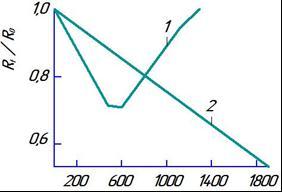
Carbon based materials obtained on the basis of petroleum coke have an electrical resistance of 7 to 100 μO hm ∙ m, while the resistance of graphite materials has a minimum value, and that of baked materials has a maximum value. The electrical conductivity of these materials is anisotropic. In materials obtained by pressing, this coefficient is high in the direction perpendicular to the pressure direction. The anisotropy coefficient varies from 1.2 to 2 and decreases with increasing dispersion of carbon matter particles [16 30].
MATERIALS AND METHODS
We have prepared a carbon heating element with an outer diameter of 96 mm, an inner diameter of 76 mm and a height of 240 mm in the form of a tube based on the composition developed on the basis of local raw materials. To determine the physical and mechanical properties of the heating element, we performed tests by replacing the carbon heating element used in a special laboratory furnace. Carbon materials with different chemical compositions were prepared during the testing process. The main technical parameters of the prepared carbon materials are given in Table 1.
Table 1 Basic technical parameters of the heating element
Name of indicators Chemical composition of the material
Material name Coke + petroleum resin Coke + molasses Coke + molasses + kaolin
Height, mm 240 240 240 Outer diameter, mm 96 96 96 Internal diameter, mm 76 76 76
The general view of the tested special laboratory furnace and the view of the samples placed in the furnace chamber are shown in Figure 2.
1 vacuum pump; 2 thermocouple; 3 manometer; 4 thermal sensor; 5 ammeter; 6 - voltmeter; 7 - cooling system; 8 - automatic; 9 - thyristor block; 10 - test sample; 11bronze contact; 12 radiator; 13 current conductor.
Figure 2. Baking in a special laboratory oven and testing the physical and mechanical properties of the material
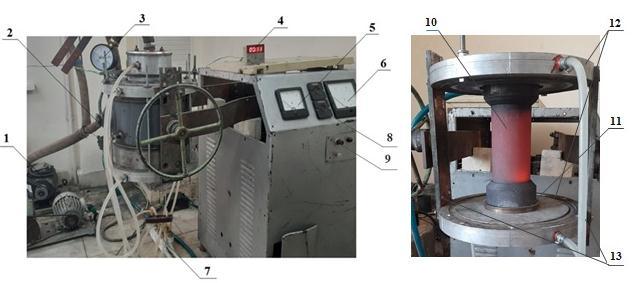


A special laboratory furnace is designed for heating samples prepared by powder metallurgy in a high vacuum or in a shielding gas environment to a temperature of 2000 0C. The outside of the oven is made of double layered steel sheet, which is constantly cooled by passing water between the sheets to prevent the oven from overheating. To keep the heat in the furnace chamber, the outer walls of the furnace are lined with heat resistant graphite brick. To start a special laboratory furnace: place the sample in the furnace and (1) draw the air in the furnace chamber (3) using a vacuum pump until the pressure gauge reaches a pressure of 1 MPa. An electric source is sent to the vacuum chamber through a transformer device by activating the oven start up (8). The change of current in the special laboratory furnace (5) is adjusted by means of the thyristor block (9). The special laboratory furnace is continuously cooled with water at a rate of 0.9 m3 / h through the cooling system (7) to ensure that the contacts of the outer casing and the heating source do not overheat. The result (4), which is determined by the thermocouple of the temperature (2) in the working chamber of a special laboratory furnace, is displayed on the thermo sensor panel.
RESEARCH RESULTS
We performed the test processes by comparing their physical and mechanical properties on three samples with different compositions. Samples of different compositions were tested as a heating element. In the test, we determined the temperature of the element depending on the values of the voltage passing through the heating elements by means of the furnace valtometer and thermocouple indicators, and the graph of their connection is shown in Figure 2
1 Coke + oil resin; 2 coke + molasses; 3 coke + molasses + kaolin.
Figure 3. The change in the heating temperature of the samples depending on the voltage values passing through the heating elements
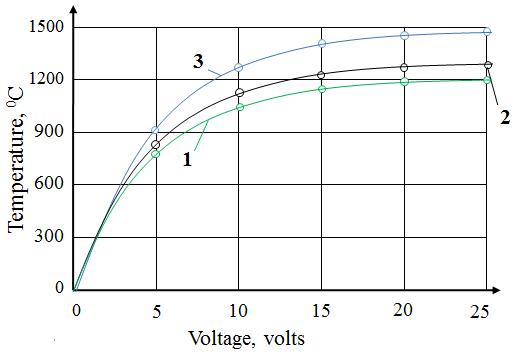
According to the test, the heating temperature of the samples also increased as the values of the electrical voltage passing through the heating elements increased. Among the test samples, a heating element containing 3 (coke + molasses + kaolin) reached a maximum heating temperature of 1480 0С at a voltage of 25 V (Figure 3). The change in temperature over time as different voltages of voltage pass through the heating elements is shown graphically in Figure 4.
a 10 volts; b 15 volts; v 20 volts; g 25 volts.
Figure 4. Temperature change over time as different amounts of electrical voltage pass through the heating elements
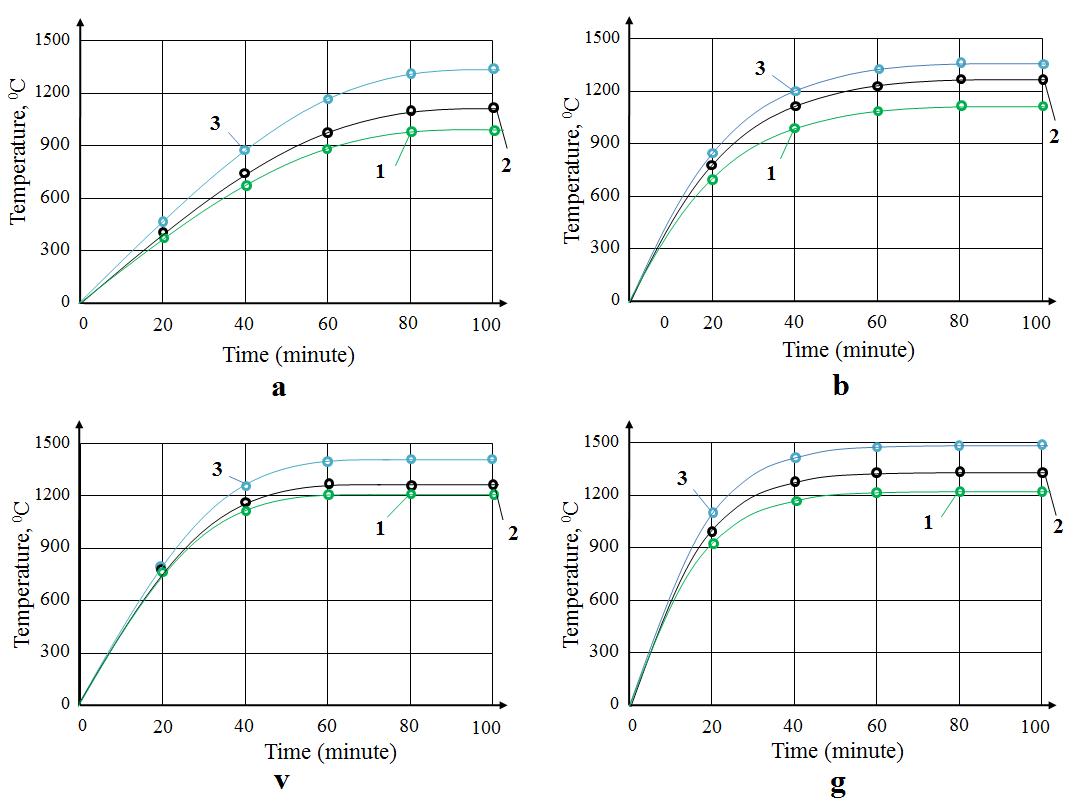
According to the test results, the heating temperature of the samples also increased over time as the voltage values passing through the heating elements increased. Among the test samples, a heating element containing 3 (coke + molasses + kaolin) was raised to a maximum temperature of 1480 0С in 60 minutes at a voltage of 25 V, and again over time the temperature value became constant (Fig. 4, g). The effect of temperature heating on the specific electrical resistance and tensile strength of the elements is shown graphically in Figure 5.
a the specific electrical resistance; b the tensile strength limit.
Figure 4. The effect of temperature heating on the specific electrical resistance and tensile strength of the elements
CONCLUSION
According to the test, the increase in temperature of the heating elements had a variable effect on its specific electrical resistance. In this case, the specific electrical resistance of the samples with the addition of molasses and kaolin decreased to a temperature of 1000 0С, and the electrical resistance also increased when the temperature rose from 1200 0С (Fig. 4, a).
As the temperature in the heating element increased, the tensile strength of the sample also increased. Among the test samples, a heating element containing 3 (coke + molasses + kaolin) had a tensile strength of 156 MPa at a temperature of 1500 0C.
The results of the test analysis show that among the heating elements made of carbon materials of different composition, a sample of 3 (coke + molasses + kaolin) has a high electrical resistance and high tensile strength under the influence of temperature and 1.2 times higher specific electrical resistance at 1500 0C. detected.
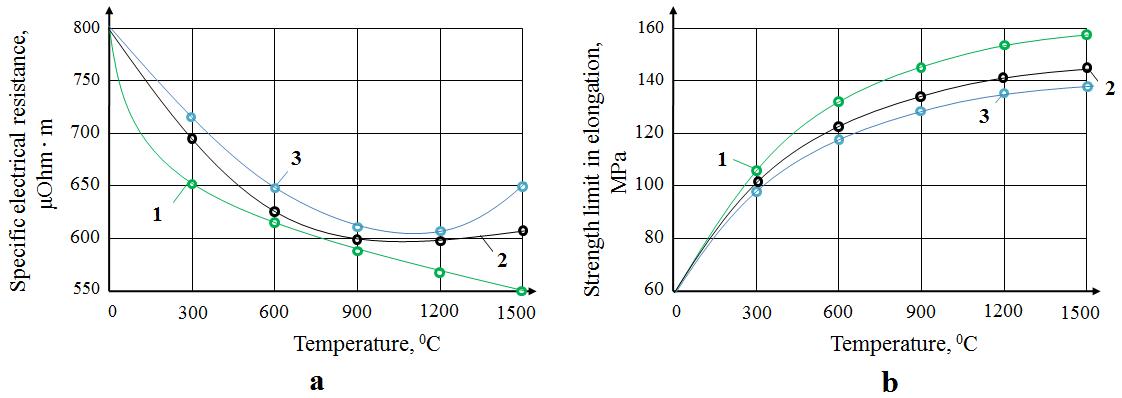


ривожлантиришдаги замонавий муаммолар» мавзусида халқаро илмий амалий конференция, Андижон ш. 2020 й., 395 403 б.
8. Karvatskii A., Leleka S., Pedchenko A., Lasariev T. Investigation of the current state of isostatic graphite production technology. // Technology audit and production reserves, 20 1 7 №2 2/1(34). P. 16 21
9. Inagaki M., Kang F., Toyoda M., Konno H. Advanced Materials Science and Engineering of Carbon. // Oxford: Butterworth Heinemann, 2014. 440 p. doi:10.1016/ c2012 0 03601 0
10. Toyo Tanso Co. Features of Special Graphite Products. Электронный ресурс http://www.ttu.com/1.Special graphite eg.pdf
11. Burchell, T. D. Carbon Materials for Advanced Technologies / T. D. Burchell. Pergamon: U.S.A. ELSEVIER SCIENCE Ltd, 1999. 540 p.
12. Savage G. (Gary) Carbon carbon composites / G. Savage. SPRINGER SCIENCE+BUSINESS MEDIA, B. V. 1st ed., 1992. 389 p.
13. Burchell T.D. A microstructurally based fracture model for polygranular graphite. // Carbon, 1996. v.34, №№ 3. P. 297 316.
14. Chung D.D.L. Review. Graphite. // J. Mat. Sci, 2002. v.37, №2 8. P. 1475 1489
15. Hoffman W.R., Huttinger K.J. Sintering of powders of polyaromatic mesophase to high strength isotropic carbons I. Influence of the raw material and sintering conditions on the properties of the carbon materials // Carbon, 1994. v.32, №2 6. P. 1087 1103.
16. Bekmirzaev, S., Saidmakhamadov, N., & Ubaydullaev, M. (2016). Obtaining sand clay casting". Theory and practice of modern. Russia, (4 (12)), 112.
Turakhodjaev, N.
Saidmakhamadov, N. M., Zokirov, R.
Odilov, F.
& Tashkhodjaeva, K. U.
Theoretical & Applied Science, (6), 675
https://emjms.academicjournal.io/index.php/


22. Shirinkhon, T., Azizakhon, T., & Nosir, S. (2020). Methods For Reducing Metal Oxidation When Melting Aluminum Alloys. International Journal of Innovations in Engineering Research and Technology, 7(10), 77 82.
23. Djahongirovich, T. N., & Muysinaliyevich, S. N. (2020). Important features of casting systems when casting alloy cast irons in sand clay molds. ACADEMICIA: An International Multidisciplinary Research Journal, 10(5), 1573 1580.
24. Nodir, T., Nosir, S., Shirinkhon, T., Erkin, K., Azizakhon, T., & Mukhammadali, A. (2021). Development Of Technology To Increase Resistance Of High Chromium Cast Iron. The American Journal of Engineering and Technology, 3(03), 85 92.
25. Nodir T. et al. Development of 280X29Nl Alloy Liquefaction Technology to Increase the Hardness and Corrosion Resistance of Cast Products //International Journal of Mechatronics and Applied Mechanics. 2021. Т. 154. С. 2021.
26. Turakhodjaev N. et al. Quality improvement of the steel melting technology in an electric arc furnace //ACADEMICIA: An International Multidisciplinary Research Journal. 2021. Т. 11. №. 7. С. 48 54.
27. Saidmakhamadov N., Abdullaev K., Khasanov J. Теория и практика современной науки //теория и практика современной науки Учредители: ООО" Институт управления и социально экономического развития". №. 2. С. 3 8.
28. Nosir S. et al. Development of High Chromium White Cast Iron Liquefaction Technology //Eurasian Journal of Engineering and Technology. 2022. Т. 4. С. 123 127.
29. Nosir S. et al. Development of technology for obtaining quality castings from steel alloys //Eurasian Journal of Engineering and Technology. 2022. Т. 5. С. 135 138.
30. Nosir S. et al. Technology for Obtaining High Quality Castings from Resistance White Cast Iron //Eurasian Journal of Engineering and Technology. 2022. Т. 5. С. 139148.
